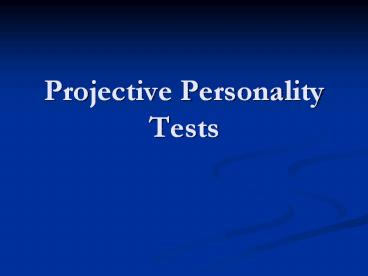Projective Personality Tests PowerPoint PPT Presentation
1 / 17
Title: Projective Personality Tests
1
Projective Personality Tests
2
Projective Personality Tests
- Based on PROJECTIVE HYPOTHESIS
- when people attempt to understand an ambiguous or
vague stimulus their interpretation of that
stimulus relfect their needs, feelings,
experiences, prior conditioning, thought
processes - Ambiguous stimuli that have been used include
- Ink blots (Rorschach)
- Ambiguous pictures (Thematic Apperception Test)
- Sentence stems
3
Popularity of Projective Tests
4
The Rorschach Inkblot Test
- use of inkblots to assess personality functioning
proposed by Binet in 1916 - Rorschach was first person to use them to
identify psychological disorders - began his inverstigations around 1911
- Psychodiagnostik 1921
- died in 1922 at age of 36
5
History of the Test
- initially unenthusiastic response to book
- David Levy brought test to US from Europe
- his student, Samuel J. Beck, wrote a no. of books
about the test, helped popularize it until his
death in 1980 - others who popularized it were Marguerite Hertz,
Bruno Klopfer, Zygmunt Piotrowski David
Rapaport - became extremely popular
- WLU library holds about 20 books on Rorschach
- there is an annual international conference just
on the Rorschach
6
Test Stimuli
- inkblots formed by dropping ink on piece of paper
folding it - Rorschach selected 10 from thousands of inkblots
he experimented with - five black gray
- 2 black, grey red
- 3 different colours
7
Administration of Test
- examiner hands card to subjects asks what
might this be - examiner keeps a verbatim record of responses to
each card, reaction time duration of responses,
position in which cards are held, spontaneous
remarks, emotional expressions - each card administered twice
- free association
- inquiry
- during inquiry, tester attempts to ascertain what
in the inkblot made person see what he/she saw
8
What might this be?
9
Scoring
10
Scoring Systems
- Content analysis
- Exners scoring system
11
Reliability Validity
- Reliability using Exners scoring system is
reasonably high (.61 to .74), but many do not
consider this to be adequate - Poor as a diagnostic tool no relationship with
- psychopathology
- conduct disorder
- antisocial personality
- depression
- PTSD
- anxiety disorder
- antisocial personality etc., etc., etc.
12
The Thematic Apperception Test (TAT)
- introduced by Christiana Morgan Henry Murray in
1935 as a method to explore unconscious thoughts
and fantasies - based on Murrays theory of needs
- test material administered to any one subject
consists of 10 or 12 cards, chosen from 31
available (1 of these being blank)
13
Administration Procedure
- I am going to show you some pictures. I want you
to tell me a story about each picture. Tell me
what led up to the story, what is happening, what
the characters are thinking and feeling, and what
the outcome will be
14
Scoring
- HERO
- character with whom subject seems to have
identified - traits of hero superiority, intelligence,
loneliness - NEEDS of the hero
- using Murrays formulation includes
achievement, agression, nurturance - scored on an intensity scale from one to five
- PRESS (environmental forces that interfere with
or facilitate satisfaction of various needs) - e.g., aggression, in which heros property or
possessions are destroyed dominance, where hero
is exposed to commands rejection, where hero is
rejected, ignored
15
Scoring (continued)
- OUTCOMES
- amount of hardship, frustration experienced
- degree of success, failure
- usually inferred from the way in which
respondents wind up their stories - THEMES
- interplay of the heros needs, press, and
unsuccessful or successful resolution of
conflicts, constitute a theme - they represent need-press combinations
- when reviewing totality of response, question is
what issues, conflicts, or dilemmas are of the
greatest concern to the respondent?
16
Reliability Validity
- mixed results for reliability and validity
- better for specific scoring protocols, such as
achievement motivation
17
Other Projective Tests
- Blacky Pictures
- Rosenzweig Picture Frustration Test
- Draw-a-Person Test
- Word Association Test
- Rotter Incomplete Sentence Blank

